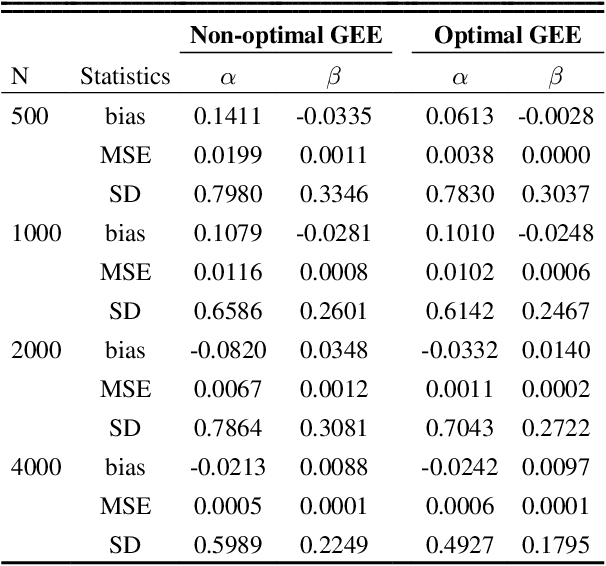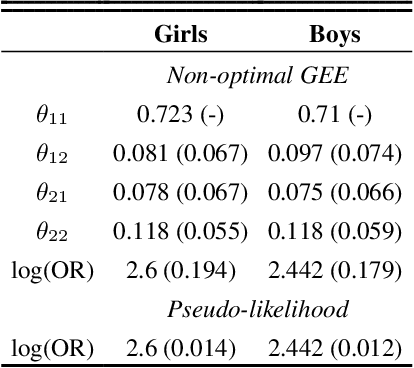Anna Guo
Average Causal Effect Estimation in DAGs with Hidden Variables: Extensions of Back-Door and Front-Door Criteria
Sep 06, 2024



Abstract:The identification theory for causal effects in directed acyclic graphs (DAGs) with hidden variables is well-developed, but methods for estimating and inferring functionals beyond the g-formula remain limited. Previous studies have proposed semiparametric estimators for identifiable functionals in a broad class of DAGs with hidden variables. While demonstrating double robustness in some models, existing estimators face challenges, particularly with density estimation and numerical integration for continuous variables, and their estimates may fall outside the parameter space of the target estimand. Their asymptotic properties are also underexplored, especially when using flexible statistical and machine learning models for nuisance estimation. This study addresses these challenges by introducing novel one-step corrected plug-in and targeted minimum loss-based estimators of causal effects for a class of DAGs that extend classical back-door and front-door criteria (known as the treatment primal fixability criterion in prior literature). These estimators leverage machine learning to minimize modeling assumptions while ensuring key statistical properties such as asymptotic linearity, double robustness, efficiency, and staying within the bounds of the target parameter space. We establish conditions for nuisance functional estimates in terms of L2(P)-norms to achieve root-n consistent causal effect estimates. To facilitate practical application, we have developed the flexCausal package in R.
Targeted Machine Learning for Average Causal Effect Estimation Using the Front-Door Functional
Dec 15, 2023Abstract:Evaluating the average causal effect (ACE) of a treatment on an outcome often involves overcoming the challenges posed by confounding factors in observational studies. A traditional approach uses the back-door criterion, seeking adjustment sets to block confounding paths between treatment and outcome. However, this method struggles with unmeasured confounders. As an alternative, the front-door criterion offers a solution, even in the presence of unmeasured confounders between treatment and outcome. This method relies on identifying mediators that are not directly affected by these confounders and that completely mediate the treatment's effect. Here, we introduce novel estimation strategies for the front-door criterion based on the targeted minimum loss-based estimation theory. Our estimators work across diverse scenarios, handling binary, continuous, and multivariate mediators. They leverage data-adaptive machine learning algorithms, minimizing assumptions and ensuring key statistical properties like asymptotic linearity, double-robustness, efficiency, and valid estimates within the target parameter space. We establish conditions under which the nuisance functional estimations ensure the root n-consistency of ACE estimators. Our numerical experiments show the favorable finite sample performance of the proposed estimators. We demonstrate the applicability of these estimators to analyze the effect of early stage academic performance on future yearly income using data from the Finnish Social Science Data Archive.
Sufficient Identification Conditions and Semiparametric Estimation under Missing Not at Random Mechanisms
Jun 10, 2023



Abstract:Conducting valid statistical analyses is challenging in the presence of missing-not-at-random (MNAR) data, where the missingness mechanism is dependent on the missing values themselves even conditioned on the observed data. Here, we consider a MNAR model that generalizes several prior popular MNAR models in two ways: first, it is less restrictive in terms of statistical independence assumptions imposed on the underlying joint data distribution, and second, it allows for all variables in the observed sample to have missing values. This MNAR model corresponds to a so-called criss-cross structure considered in the literature on graphical models of missing data that prevents nonparametric identification of the entire missing data model. Nonetheless, part of the complete-data distribution remains nonparametrically identifiable. By exploiting this fact and considering a rich class of exponential family distributions, we establish sufficient conditions for identification of the complete-data distribution as well as the entire missingness mechanism. We then propose methods for testing the independence restrictions encoded in such models using odds ratio as our parameter of interest. We adopt two semiparametric approaches for estimating the odds ratio parameter and establish the corresponding asymptotic theories: one involves maximizing a conditional likelihood with order statistics and the other uses estimating equations. The utility of our methods is illustrated via simulation studies.
 Add to Chrome
Add to Chrome Add to Firefox
Add to Firefox Add to Edge
Add to Edge